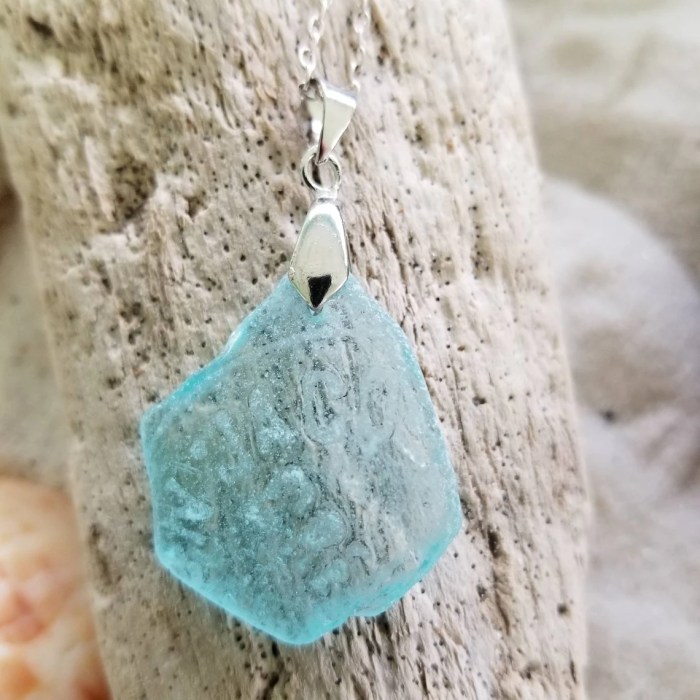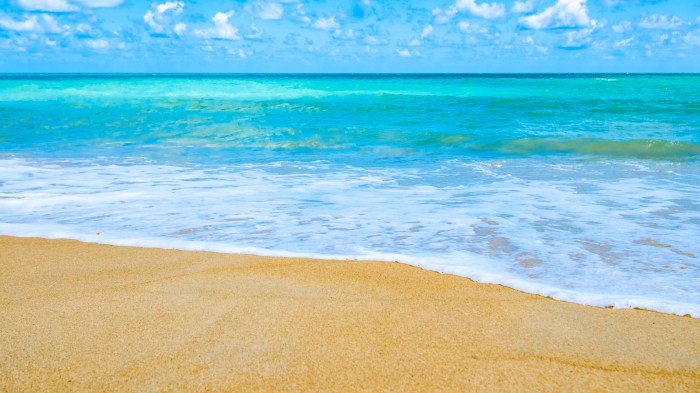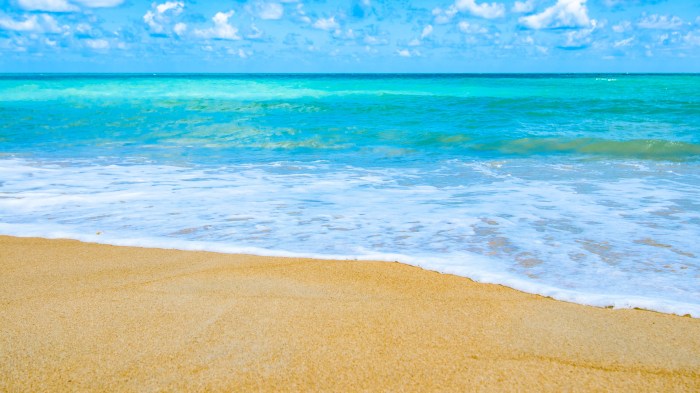Blue beach glass, a captivating treasure discovered along shorelines, holds a captivating story of natural processes, cultural significance, and artistic inspiration. Its vibrant hue and smooth texture have fascinated beachcombers and collectors for centuries, making it a symbol of tranquility, creativity, and connection to the ocean.
Formed through the tumbling and erosion of discarded glass over decades or even centuries, blue beach glass is a testament to the power of nature’s transformative abilities. Its composition and properties, influenced by the original glass’s chemical makeup and the relentless forces of the sea, give it unique characteristics that distinguish it from other types of beach glass.
History and Origin
The mesmerizing blue beach glass we find today is a result of centuries-old processes and human interactions. Its origins lie in the discarded blue glass objects that once served various purposes.
Historically, blue glass has been used in diverse cultures and industries. The ancient Egyptians, renowned for their craftsmanship, employed cobalt to create vibrant blue glass for jewelry, amulets, and decorative objects. In the Middle Ages, blue glass played a significant role in stained glass windows, adorning cathedrals and churches with intricate and colorful designs.
Formation of Blue Beach Glass
The formation of blue beach glass is a captivating natural phenomenon. When glass objects, often discarded bottles or tableware, find their way into the ocean or other water bodies, they embark on a transformative journey.
- Erosion:The relentless waves and tumbling action of water relentlessly batter the glass, gradually breaking it down into smaller fragments.
- Tumbling:As the fragments are tossed and turned by the water’s currents, they collide with sand, pebbles, and other objects, further shaping and smoothing their surfaces.
- Chemical Alteration:The seawater’s chemical composition, particularly its salt content, interacts with the glass, causing its surface to undergo a process called “devitrification.” This process alters the glass’s structure, resulting in a frosted and opaque appearance.
- Coloration:The characteristic blue hue of beach glass is primarily attributed to the presence of trace amounts of iron and manganese impurities within the original glass. These impurities react with the seawater, creating the distinctive blue coloration.
Composition and Properties
Blue beach glass is a type of sea glass that has been weathered and tumbled by the ocean, resulting in its distinctive blue hue. Its composition and properties are influenced by the original glass from which it originated, as well as the weathering process it undergoes.
Strolling along the coast, the shimmering blue beach glass reflects the serenity of the deserted shoreline. These ethereal fragments, remnants of discarded bottles, evoke a sense of solitude and abandonment. Just as these beaches offer a glimpse into a forgotten past, London holds hidden gems of deserted places, where time seems to stand still.
From the eerie grandeur of deserted places in london to the tranquil beauty of overgrown gardens, these forgotten corners invite exploration and contemplation. And as the waves gently caress the beach glass, a reminder of the ephemeral nature of all things, we are left with a sense of wonder and appreciation for the hidden treasures that lie beneath the surface.
The chemical composition of blue beach glass primarily consists of silica (SiO2), which forms the glass’s network structure. Other elements present include sodium (Na), calcium (Ca), magnesium (Mg), and aluminum (Al), which contribute to its physical and chemical properties.
Mineral Content
- Quartz (SiO2):The primary mineral component of blue beach glass, providing its glassy texture and hardness.
- Albite (NaAlSi3O8):A feldspar mineral that contributes to the glass’s whiteness and opacity.
- Anorthite (CaAl2Si2O8):Another feldspar mineral that increases the glass’s strength and durability.
Physical Properties
Blue beach glass exhibits a range of physical properties that distinguish it from other types of glass:
- Texture:Smooth and glassy, with a slight surface roughness due to weathering.
- Hardness:Typically between 5 and 6 on the Mohs scale, making it relatively resistant to scratching.
- Transparency:Varies depending on the thickness and impurities present, ranging from translucent to opaque.
- Color:Blue, with shades varying from light blue to deep cobalt, caused by the presence of iron and cobalt impurities.
Environmental Impact
The accumulation of blue beach glass along coastal areas poses both environmental concerns and potential benefits.
Marine Pollution
Beach glass is a type of marine litter that contributes to ocean pollution. When broken glass from bottles, windows, or other sources enters the ocean, it can take hundreds of years to decompose. Over time, the glass fragments are tumbled and smoothed by the waves and sand, forming the characteristic frosted appearance of beach glass.
The presence of beach glass in marine environments can have several negative impacts:
- Habitat Degradation:Large accumulations of beach glass can alter the physical structure of coastal habitats, such as sand dunes and intertidal zones. This can disrupt the natural ecosystem and affect the survival and reproduction of marine organisms.
- Microplastic Formation:As beach glass breaks down further, it can form microplastics, which are tiny pieces of plastic that can be ingested by marine animals. Microplastics can accumulate in the food chain and potentially cause health problems for wildlife.
- Chemical Leaching:Some types of glass, such as colored or tempered glass, may contain chemicals that can leach into the water. These chemicals can be harmful to marine life and can disrupt the delicate balance of coastal ecosystems.
Benefits of Beach Glass Accumulation
Despite its potential environmental concerns, beach glass accumulation can also have some benefits:
- Coastal Protection:In some areas, large accumulations of beach glass can act as a natural buffer against erosion. The glass fragments help to stabilize the shoreline and prevent sand loss during storms and high tides.
- Artistic and Cultural Value:Beach glass has become a popular material for jewelry, art, and crafts. The unique colors and textures of beach glass make it a valuable resource for local artisans and businesses.
- Educational Tool:Beach glass can serve as an educational tool to raise awareness about marine pollution and the importance of protecting coastal ecosystems.
Balancing the potential environmental impacts of beach glass accumulation with its benefits requires a holistic approach. Proper waste management practices, public education, and coastal restoration efforts are essential to minimize the negative effects of marine litter while preserving the unique characteristics and value of beach glass.
Collecting and Identification

Finding blue beach glass requires a keen eye and a bit of patience. Look for pieces that are smooth and rounded, as these have been tumbled by the waves for a longer period of time. The color of blue beach glass can vary from light blue to deep cobalt, and the intensity of the color can indicate its age and rarity.
Types of Blue Beach Glass
- Cobalt Blue:The most common type of blue beach glass, cobalt blue is created from broken cobalt bottles. It is typically a deep, rich blue color.
- Aqua Blue:Aqua blue beach glass is made from broken clear bottles that have a slight blue tint. It is less common than cobalt blue.
- Sapphire Blue:Sapphire blue beach glass is rare and highly sought after by collectors. It is created from broken sapphire glass, which is a type of blue gemstone.
- Cornflower Blue:Cornflower blue beach glass is also rare and is created from broken cornflower blue glass, which is a type of cobalt blue glass with a slightly purple hue.
Artistic and Decorative Uses
Blue beach glass, with its captivating hues and smooth texture, has become a popular material for artistic and decorative purposes. Its unique qualities lend themselves to a wide range of creative applications, from intricate jewelry to vibrant home décor.
In Jewelry
In the realm of jewelry, blue beach glass finds expression in necklaces, earrings, bracelets, and pendants. Artisans carefully select pieces of glass that exhibit the desired shape, color, and texture, combining them with other materials such as silver, gold, or leather to create stunning pieces.
The glass’s translucent nature allows light to play through, casting ethereal glows and highlighting its unique patterns.
In Home Décor, Blue beach glass
Beyond jewelry, blue beach glass adds a touch of coastal charm to home décor. It can be used to create decorative bowls, vases, and candle holders. Larger pieces can be transformed into wind chimes, wall hangings, or even mosaic tabletops.
The glass’s versatility allows it to complement various interior design styles, from coastal chic to modern minimalism.
Techniques and Processes
Crafting with blue beach glass requires patience and skill. Artisans typically begin by collecting the glass from beaches or other coastal areas. Once collected, the glass is cleaned and sorted based on color, shape, and size. Depending on the intended use, the glass may be further processed by tumbling or grinding to enhance its smoothness or create specific shapes.
In jewelry making, the glass is often wire-wrapped or set in metal to create pendants or beads. In home décor, the glass can be glued or mortared onto surfaces to create mosaics or decorative accents. The techniques used vary depending on the artist’s vision and the desired outcome.
Scientific Applications
Blue beach glass serves as a valuable tool in scientific research and environmental monitoring due to its durability, ubiquity, and ability to provide insights into marine pollution and coastal processes.
Researchers have utilized blue beach glass to analyze the distribution and composition of microplastics in marine environments. Microplastics, tiny plastic particles less than 5 mm in size, pose a significant threat to marine life and ecosystems. By studying the accumulation of microplastics on blue beach glass, scientists can gain insights into the sources, transport pathways, and potential ecological impacts of these pollutants.
Coastal Processes
Blue beach glass has also been used to investigate coastal processes such as erosion and sediment transport. The shape, size, and surface texture of beach glass can provide information about the wave energy, currents, and sediment dynamics in a particular coastal environment.
By analyzing beach glass samples collected over time, researchers can track changes in coastal morphology and identify areas at risk of erosion or flooding.
Cultural Significance
Blue beach glass holds cultural significance in various regions, becoming deeply entwined with folklore, legends, and traditions.Finding and collecting blue beach glass is often associated with good luck, prosperity, and the fulfillment of wishes. In some cultures, it is believed that each color of beach glass represents a different wish or aspiration, with blue symbolizing peace, tranquility, and harmony.
Folklore and Legends
Blue beach glass is often associated with tales of lost sailors and shipwrecks. According to legend, blue beach glass originates from the bottles used to store medicine and rum on ships. When these ships met their demise, the bottles would shatter, creating the colorful fragments that wash ashore.In
some cultures, blue beach glass is said to be a reminder of loved ones who have passed away. It is believed that their spirits reside within the glass, watching over those who find it.
Traditions and Practices
Collecting blue beach glass has become a popular pastime in many coastal areas. People often spend hours searching for these precious fragments, using them to create jewelry, art, and decorative items.In some cultures, blue beach glass is used in rituals and ceremonies.
It is believed to bring good fortune and protection to those who possess it.
Economic Value
Blue beach glass, a sought-after collectible, derives its economic value from several factors:
Rarity and Condition:Genuine blue beach glass is uncommon, and its value increases with its age, size, and intactness. Glass from the 19th and early 20th centuries is particularly valuable due to its rarity.
Color and Transparency:The intensity and purity of the blue hue are significant factors. Cobalt blue glass, with its deep and vibrant color, is highly prized. Clear and transparent glass is more valuable than opaque or cloudy pieces.
Shape and Form:Unique and interesting shapes, such as sea-polished marbles, shards, or tumbled pieces, add to the value. Bottles, jars, and other recognizable forms are also sought after.
Commercial Uses and Markets
Blue beach glass finds commercial use in various markets:
- Jewelry:Glass is crafted into pendants, earrings, bracelets, and other jewelry pieces, with intricate designs and settings enhancing their value.
- Decorative Objects:Blue beach glass is used in home décor, creating vases, sculptures, wind chimes, and other decorative items that bring a touch of the ocean indoors.
- Art and Collectibles:Collectors seek rare and unique pieces for display and investment purposes. Blue beach glass is often featured in art exhibitions and galleries.
Conservation and Preservation: Blue Beach Glass
Blue beach glass is a finite resource that can be preserved for future generations through responsible collecting and conservation practices.
When collecting blue beach glass, it is important to minimize environmental impact by leaving the beach as you found it. Avoid disturbing natural habitats, and dispose of any trash properly.
Responsible Collecting
- Only collect loose pieces of glass that are not embedded in the sand or attached to living organisms.
- Avoid digging or sifting through the sand, as this can damage the beach ecosystem.
- Respect private property and do not collect glass from areas where it is prohibited.
- Limit the amount of glass you collect to avoid depleting the resource.
- Share your knowledge of responsible collecting with others to promote conservation.
Preservation
Preserving blue beach glass for future generations involves protecting it from damage and decay. Store your collection in a cool, dry place away from direct sunlight, as UV rays can fade the glass over time.
Clean your glass gently with a soft cloth or brush to remove any dirt or salt. Avoid using harsh chemicals or abrasives, as these can scratch or damage the surface.
Inspiration and Symbolism
Blue beach glass, a product of nature’s transformative powers, holds profound symbolic meanings that inspire creativity, tranquility, and a deep connection to the ocean’s embrace.
Its enigmatic azure hue, a testament to the ocean’s depths, evokes a sense of serenity and calm. It whispers tales of tranquility, inviting us to pause and reflect amidst the ebb and flow of life.
Creativity and Imagination
The unique textures and organic shapes of blue beach glass spark imagination and ignite creative expression. Its smooth, frosted surface beckons artists and artisans to transform it into exquisite jewelry, mosaics, and sculptures.
The vibrant blue hue stimulates the mind, enhancing focus and fostering a sense of inspiration. It encourages the exploration of new ideas, promotes problem-solving, and unleashes a torrent of artistic possibilities.
Connection to the Ocean
Blue beach glass embodies the vastness and allure of the ocean. Each piece holds a story of its journey through the waves, carrying the whispers of distant shores and the secrets of marine life.
Finding blue beach glass is akin to receiving a gift from the sea. It fosters a deep appreciation for the ocean’s beauty and fragility, inspiring a sense of stewardship and responsibility toward this vital ecosystem.
Closing Summary

As we delve into the multifaceted world of blue beach glass, we explore its environmental impact, examining both its potential hazards and benefits for coastal ecosystems. We provide tips for identifying and collecting this marine treasure, highlighting the different types and their relative rarity.
Additionally, we delve into the artistic and decorative uses of blue beach glass, showcasing its versatility and beauty in various creations.
Moreover, we uncover the scientific applications of blue beach glass, demonstrating its role in environmental monitoring and marine pollution research. Its cultural significance is also examined, exploring the folklore, legends, and traditions associated with finding and collecting this enigmatic gem.
Finally, we discuss the economic value and conservation efforts surrounding blue beach glass, emphasizing the importance of responsible collecting and preserving this unique treasure for future generations.
Question Bank
What is the rarest color of beach glass?
Red beach glass is the rarest color due to the limited production of red glass in the past.
How can you tell if beach glass is real?
Genuine beach glass has a smooth, frosted surface caused by erosion, while fake glass may have sharp edges or a glossy finish.
What is the best time to find beach glass?
After storms or high tides, when the waves have churned up the sand and revealed hidden treasures.



